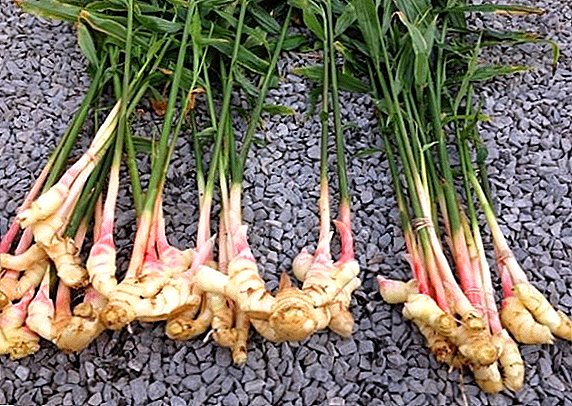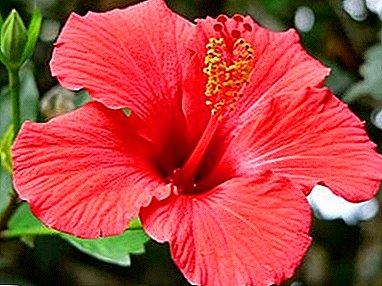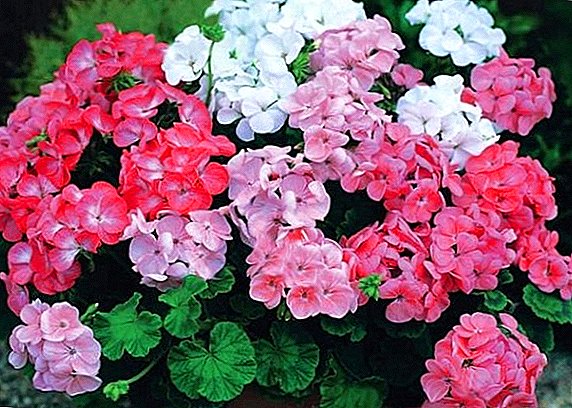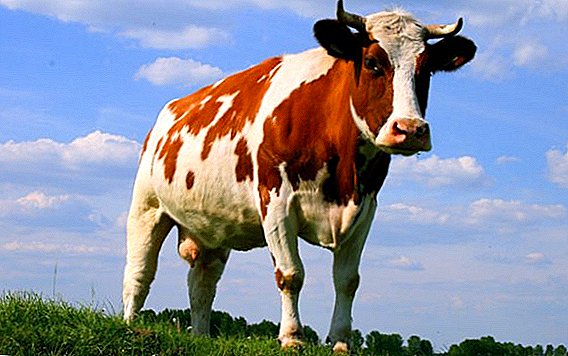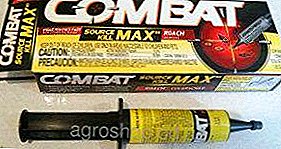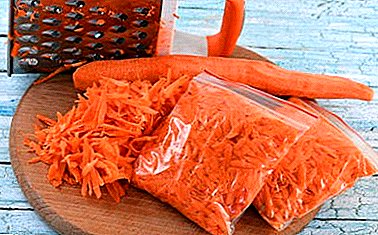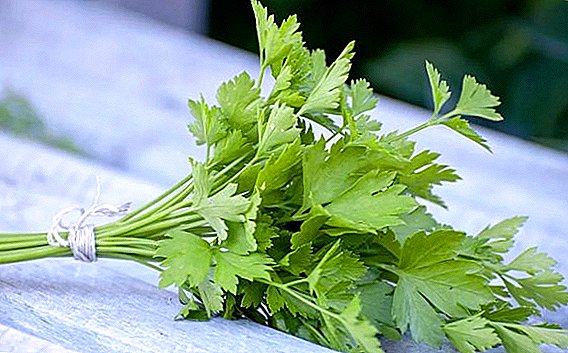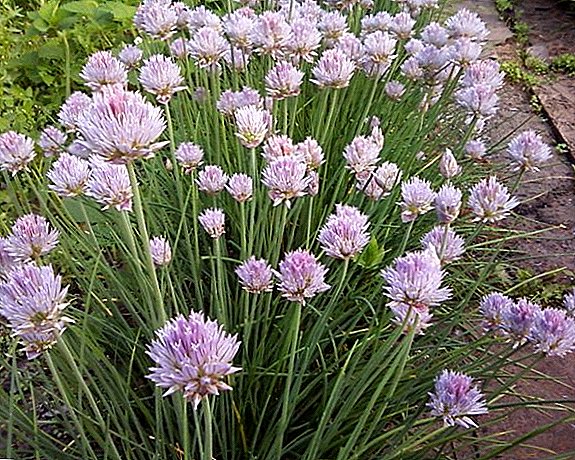 Chives or onions like to grow admirers of early vitamin and juicy greens. In German, the name "Schnitt" means "plant for cutting green." However, the culture is often grown not only to obtain feather greens, but also for decorative purposes. Chives have beautiful lilac-pink spherical inflorescences, which, blooming from the beginning of May, are able to decorate any cottage and house adjoining plot. Chives are distinguished by unpretentiousness and simplicity of agricultural technology, therefore its cultivation and care will not be difficult for even novice gardeners.
Chives or onions like to grow admirers of early vitamin and juicy greens. In German, the name "Schnitt" means "plant for cutting green." However, the culture is often grown not only to obtain feather greens, but also for decorative purposes. Chives have beautiful lilac-pink spherical inflorescences, which, blooming from the beginning of May, are able to decorate any cottage and house adjoining plot. Chives are distinguished by unpretentiousness and simplicity of agricultural technology, therefore its cultivation and care will not be difficult for even novice gardeners.
Did you know? Chives have several names: each country has its own. For example, in Portugal and Italy it is called the "English onion"; in southern Europe - "tribulka"; In Bulgaria - "speed"; and in Ukraine it is known as "Rezan" or "Rezun". Today, culture is grown everywhere not only in Europe, but also in the USA, India, China, Iran, Japan, and Russia.
Skoroda: description and biological features
Chives are a perennial plant of the Onion family. It has narrow, awl-shaped leaves, 25-40 cm long. The bulbs are elongated, oblong, egg-shaped, 2-4 cm in length, smoothly turning into a false stem. This is a very valuable type of onion, largely due to its chemical composition. It contains 10-12% of dry matter, about 3% of sugars, up to 3.9% of protein, as well as valuable amino acids: arginine, histidine, lysine, methionine, tryptophan, etc. Mineral salts, which contain boron and iron, accumulate in onion leaves. , calcium, potassium, manganese, molybdenum, sulfur, zinc, etc., as well as vitamin C (from 40 to 140 mg /%), carotene (from 3.3 to 6 mg /%).
 Onions Schnitt, like other representatives of Onions, contains phytoncides, therefore its useful properties are highly valued and used in the treatment and prevention of infectious diseases. The plant has a number of biological features, among which is high frost resistance. So, the bow tolerates wintering in the open ground even in Eastern Siberia and in the Arctic. Thanks to this feature, greens of chives in mid-latitudes can be obtained until late autumn, and sometimes even in December.
Onions Schnitt, like other representatives of Onions, contains phytoncides, therefore its useful properties are highly valued and used in the treatment and prevention of infectious diseases. The plant has a number of biological features, among which is high frost resistance. So, the bow tolerates wintering in the open ground even in Eastern Siberia and in the Arctic. Thanks to this feature, greens of chives in mid-latitudes can be obtained until late autumn, and sometimes even in December.
At one place onions can grow up to 10 years, but the richest crop is obtained with two to three years of cultivation. Culture blooms in the second year of the growing season, and its floral arrows are thin, up to 30-50 cm in length. The flowers are small, spherical, purple, pink and purple. Flowers of chives can also be white in color, such as in the new variety "Elvi".
Did you know? White flowering chives are very rare, only in the Scandinavian mountain meadows. According to legend, in the far north of Sweden lives a beautiful elf named Elvi, - Princess of purity and magic. In her honor, and was named belotsvetkovyy variety chives. The white flowers of the plant at sunset are cast with beautiful mother-of-pearl, and under the moonlight they have a silver sheen.
Place and soil for planting
The soil for the plant is prepared in the fall. Before planting the chives, ground up to a depth of 30 cm and make 7-10 kg / mg of organic matter: humus, compost, and mineral fertilizers: superphosphate and urea, 1 tbsp. spoon for 1 m² of soil. In the spring, just before planting, the area needs to be leveled, the soil is well cut and compacted. Schnitt-onions grow well on moist, loose, fertile, well-drained, not waterlogged, loamy soils rich in lime. The place is better to choose a sunny, well-warmed.
Important! You should not plant chives on dry sandy soils, as they do not retain moisture and destroy the plant.
Sowing seeds
 Chives have very small seeds, half as large as those of the bulb, therefore growing crops from seeds involves preliminary preparation of the soil and planting material. Seeds need to soak for a day in a growth stimulator or water, periodically changing it. Then you need to get the seeds and dried. Planting material is sown according to the following scheme: 45-50 x 25-30 cm, to a depth of 0.7-1.5 cm. After disembarking, they should be sprinkled with damp earth, slightly compacted, and again sprinkled with loose soil.
Chives have very small seeds, half as large as those of the bulb, therefore growing crops from seeds involves preliminary preparation of the soil and planting material. Seeds need to soak for a day in a growth stimulator or water, periodically changing it. Then you need to get the seeds and dried. Planting material is sown according to the following scheme: 45-50 x 25-30 cm, to a depth of 0.7-1.5 cm. After disembarking, they should be sprinkled with damp earth, slightly compacted, and again sprinkled with loose soil.
Shoots appear about a week and a half after sowing. As soon as they seem, the soil between the rows must be loosened in order to saturate the roots with oxygen. In the phase of the first leaf, the seedlings are thinned, leaving a distance of 10-15 cm between them. In the first year of the growing season, the crops are watered and weeded, and at the end of the season they mulch with sawdust, peat and rice husk.
You can plant seeds both in summer and in winter, but it is best to do it in spring. In late April - early May, when the ground is warm enough, you can sow onions.
Vegetative reproduction of chives
Vegetatively propagated culture in the spring. At the same time, adult bushes are divided into planting units, which contain 4-5 branches each. Before planting, the roots and leaves are shortened so that the height from the bottom to the top is about 15 cm and the length of the roots is up to 7-8 cm. Planting material is planted according to the same pattern as the seeds: 45-50 x 25-30 cm, deep wells. After planting, the soil is crushed and watered abundantly.
Agricultural technology of growing chives
 Agrotechnics cultivation of onion chives is in the standard measures for the care of crops: watering, weeding, loosening the soil and feeding. When sowing chives in the seed way in the first year of the growing season, the crop is not harvested, and when planted by dividing, the leaves are selectively cut in late May-early June. It is also necessary to periodically loosen the soil, remove the weeds, cut off the arrows and remove the dead leaves of chives. Watering should be carried out 2-3 times per season: after each cut leaves, using a large amount of water. Feed planting complex mineral and organic fertilizers, alternating between them.
Agrotechnics cultivation of onion chives is in the standard measures for the care of crops: watering, weeding, loosening the soil and feeding. When sowing chives in the seed way in the first year of the growing season, the crop is not harvested, and when planted by dividing, the leaves are selectively cut in late May-early June. It is also necessary to periodically loosen the soil, remove the weeds, cut off the arrows and remove the dead leaves of chives. Watering should be carried out 2-3 times per season: after each cut leaves, using a large amount of water. Feed planting complex mineral and organic fertilizers, alternating between them.
Diseases and pests of onion speeding
The most common diseases that can affect chives are neck rot, bacterial rot and downy mildew. Neck rot spreads into tissue through mechanical damage; Bacterial rot manifests itself in yellowing of leaves and tissue death. Downy mildew, which causes the fungus, is very dangerous for chives and appears in the middle of summer, closer to the time of ripening. The infection persists in the affected bulb, which is the carrier of the disease. The bulb does not rot until it is planted in the ground. To combat these diseases, you can use fungicides, for example, "Benlat" 0.7%. The bulbs are placed in suspension for 20 minutes before putting it in storage, and then dried. Also effective fungicide "Tigam", which is treated with seeds before planting.
Of insect pests for chive onions, the onion fly is the most dangerous, which attacks its landing in spring. The pest is widespread mainly on sandy and loamy soils, rarely on peat soils. As a preventive measure for onion flies, it is necessary to isolate new onion crops from last year’s ones, and also alternate the rows of onions with carrots. The leaves of carrots during the growing season produce phytoncides that scare the parasite. It is also considered to be effective as soon as possible to plant chives in open ground. Since a previously planted onion has time to get stronger and harden when a fly appears, the larvae cannot penetrate the plants.
 It is recommended to mulch rows of chives with peat, which also contributes to scaring onion flies. The use of preparations with a strong specific smell, like naphthalene (with 1: 1 sand), clean tobacco dust or mixed with half lime, ash (1.5-2.0 kg per 10 m²), helps. Be sure to periodically remove and burn the affected plants.
It is recommended to mulch rows of chives with peat, which also contributes to scaring onion flies. The use of preparations with a strong specific smell, like naphthalene (with 1: 1 sand), clean tobacco dust or mixed with half lime, ash (1.5-2.0 kg per 10 m²), helps. Be sure to periodically remove and burn the affected plants.
Planting can be sprayed with tobacco infusion: 400 g of shredded tobacco insist in 10 liters of water for 24 hours. Then strain, add 40 grated soap and mix.
Green cleaning
Onion shnitt clean on greens in May. On farms, during mass cultivation, onions are often harvested along with the bulbs: the plants are removed from the ground, packaged and sent for sale. The productivity of chives can reach 50 tons per hectare.
In gardens and summer cottages, greens are harvested without digging out the bulbs, but simply by cutting off fresh leaves as they grow 2-3 times during the growing season, before flowering. After cutting it is necessary to add dressing and water the culture. In the last year of growing onions removed in the fall, immediately removing the bulbs. Green onions are used after cutting or stored at -1 ° C in a refrigerator, packed in plastic bags. Fresh greens are stored for no more than 10-12 days.
Application and beneficial properties of chives
 Virtually every cook knows what chives are and how rich is its nutritional value. Greens of onions are used for making salads, soups, as a garnish for fish, meat and offal, as well as for decorating various dishes. Taste, healthy and nutritional properties of this type of onion are superior to all other members of this family. The taste of chives is very juicy, does not taste bitter, has a savory sweetish taste. Many cooks make greens: it is salted, dried and even kvasyat.
Virtually every cook knows what chives are and how rich is its nutritional value. Greens of onions are used for making salads, soups, as a garnish for fish, meat and offal, as well as for decorating various dishes. Taste, healthy and nutritional properties of this type of onion are superior to all other members of this family. The taste of chives is very juicy, does not taste bitter, has a savory sweetish taste. Many cooks make greens: it is salted, dried and even kvasyat.
Indisputable is also the benefits that chives onions bring to the human body. For example, when atherosclerosis, diseases of the cardiovascular system, liver and kidneys, and problems with the gallbladder.
 Chives are considered to be a light aphrodisiac, which means that it can be used in combination with stronger drugs to get rid of sexual impotence. Chive helps with disruption of the gastrointestinal tract, stimulates the appetite. It is low-calorie, which allows you to include a culture in the diet of those who want to lose weight.
Chives are considered to be a light aphrodisiac, which means that it can be used in combination with stronger drugs to get rid of sexual impotence. Chive helps with disruption of the gastrointestinal tract, stimulates the appetite. It is low-calorie, which allows you to include a culture in the diet of those who want to lose weight.
Thanks the presence of a large amount of vitamin C in the composition, chives can restore the body after seasonal colds and respiratory infections, as well as strengthen the immune system.


